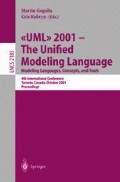Abstract
Object-oriented modeling favors the modeling of object behavior from different viewpoints and at different levels of abstraction. This gives rise to consistency problems between overlapping or semantically related submodels. The absence of a formal semantics for the UML and the numerous ways of employing the language within the development process lead to a number of different consistency notions. Therefore, general meta-level techniques are required for specifying, analyzing, and communicating consistency constraints. In this paper, we discuss the issue of consistency of behavioral models in the UML and present techniques for specifying and analyzing consistency. Using meta-model rules we transform elements of UML models into a semantic domain. Then, consistency constraints can by specified and validated using the language and the tools of the semantic domain. This general methodology is exemplified by the problem of protocol statechart inheritance.
Access this chapter
Tax calculation will be finalised at checkout
Purchases are for personal use only
Preview
Unable to display preview. Download preview PDF.
References
L. Baresi and M. Pezzè. Improving UML with Petri nets. In A. Corradini and M. Bauderon, editors, Proc. ETAPS 2001 Workshop on Uniform Approaches to Graphical Process Specification Techniques (UniGra 2001), Genova, Italy, Electronic Notes in TCS 51. Elsevier Science, 2001.
E. Boiten, H. Bowman, J. Derrick, and M. Steen. Viewpoint consistency in Z and LOTOS: A case study. In J. Fitzgerald, C. B. Jones, and P. Lucas, editors, Proc. 4th Intl. Symposium of Formal Methods Europe, Graz, Austria, LNCS 1313, pages 644–664. Springer-Verlag, 1997.
B. Cheng, L. Campbell, and E. Wang. Enabling automated analysis through the formalization of object-oriented modeling diagrams. In Proc. IEEE Intl. Conference on Dependable Systems and Networks. IEEE Computer Society, 2000.
J. Ebert and G. Engels. Structural and behavioral views of OMT-classes. In E. Bertino and S. Urban, editors, Proc. Object-Oriented Methodologies and Systems, LNCS 858, pages 142–157. Springer-Verlag, 1994.
G. Engels and L. Groenewegen. Object-oriented modeling: A roadmap. In A. Finkelstein, editor, Future Of Software Engineering 2000, pages 105–116. ACM, 2000.
G. Engels, R. Hücking, St. Sauer, and A. Wagner. UML collaboration diagrams and their transformation to Java. In R. France and B. Rumpe, editors, Proc. UML’99, Fort Collins, CO, USA, LNCS 1723, pages 473–488. Springer-Verlag, 1999.
G. Engels, J. M. Küster, L. Groenewegen, and R. Heckel. A methodology for specifying and analyzing consistency of object-oriented behavioral models. In V. Gruhn, editor, Proc. European Software Engineering Conference (ESEC/FSE 2001), Vienna, Austria. To appear.
Formal Systems Europe (Ltd). Failures-Divergence-Refinement: FDR2 User Manual, 1997.
P. Fradet, D. Le Métayer, and M. Périn. Consistency checking for multiple view software architectures. In O. Nierstrasz and M. Lemoine, editors, Proc. European Software Engineering Conference (ESEC/FSE 1999), LNCS 1687, pages 410–428. Springer-Verlag / ACM Press, 1999.
C. Ghezzi and B. A. Nuseibeh. Special Issue on Managing Inconsistency in Software Development (1). IEEE Transactions on Software Engineering, 24(11), November 1998.
C. Ghezzi and B. A. Nuseibeh. Special Issue on Managing Inconsistency in Software Development (2). IEEE Transactions on Software Engineering, 25(11), November 1999.
M. Große-Rhode. Algebra transformation systems and their compositions. In Proc. Fundamental Approaches to Software Engineering (FASE 1998), LNCS 1382, pages 107–122. Springer-Verlag, 1998.
D. Harel and O. Kupferman. On the Inheritance of State-Based Object Behavior. Technical Report MCS99-12, Weizmann Institute of Science, Faculty of Mathematics and Computer Science, June 1999.
C. A. R. Hoare. Communcating Sequential Processes. Prentice Hall, 1985.
I. Jacobson, G. Booch, and J. Rumbaugh. The Unified Software Development Process. Addison Wesley, 1999.
J. M. Küster and J. Stroop. Consistent design of embedded real-time systems with UML-RT. In Proc. 4th IEEE International Symposium on Object-Oriented Real-Time Distributed Computing (ISORC’2001), 2001.
X. Li and J. Lilius. Timing analysis of UML sequence diagrams. In R. France and B. Rumpe, editors, Proc. UML’99, Fort Collins, CO, USA, LNCS 1723, pages 661–674. Springer-Verlag, 1999.
A. Moreira and R. Clark. Combining object-oriented modeling and formal description techniques. In M. Tokoro and R. Pareschi, editors, Proc. 8th European Conference on Object-Oriented Programming (ECOOP’94), LNCS 821, pages 344–364. Springer-Verlag, 1994.
Object Management Group. Analysis and design platform task force-white paper on the profile mechanism, April 1999. http://www.omg.org/pub/docs/ad/99-04-07.pdf.
Object Management Group. UML specification version 1.4, 2001. http://www.omg.org.
T. W. Pratt. Pair grammars, graph languages and string-to-graph translations. Journal of Computer and System Sciences, 5:560–595, 1971.
Jean Louis Sourrouille. UML behavior: Inheritance and implementation in current object-oriented languages. In R. France and B. Rumpe, editors, Proc. UML’99, Fort Collins, CO, USA, LNCS 1723, pages 457–472. Springer-Verlag, 1999.
Markus Stumptner and Michael Schrefl. Behavior consistent inheritance in UML. In A. H. F. Laender, S. W. Liddle, and V. C. Storey, editors, Proc. 19th International Conference on Conceptual Modeling, Salt Lake City, Utah, USA, LNCS 1920. pages 527–542. Springer-Verlag, 2000.
Author information
Authors and Affiliations
Editor information
Editors and Affiliations
Rights and permissions
Copyright information
© 2001 Springer-Verlag Berlin Heidelberg
About this paper
Cite this paper
Engels, G., Heckel, R., Küster, J.M. (2001). Rule-Based Specification of Behavioral Consistency Based on the UML Meta-model. In: Gogolla, M., Kobryn, C. (eds) ≪UML≫ 2001 — The Unified Modeling Language. Modeling Languages, Concepts, and Tools. UML 2001. Lecture Notes in Computer Science, vol 2185. Springer, Berlin, Heidelberg. https://doi.org/10.1007/3-540-45441-1_21
Download citation
DOI: https://doi.org/10.1007/3-540-45441-1_21
Published:
Publisher Name: Springer, Berlin, Heidelberg
Print ISBN: 978-3-540-42667-7
Online ISBN: 978-3-540-45441-0
eBook Packages: Springer Book Archive

